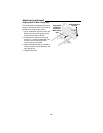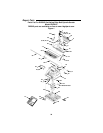
26
Basic Sanding Operation
Sandpaper Selection
Selecting the correct size diameter, cor-
rect size grit, and correct type sandpaper
is an extremely important step in achiev-
ing a high quality sanded finish. Aluminum
oxide, silicon carbide, and other synthetic
abrasives are best for power sanding.
Natural abrasives, such as flint and gar-
net, are too soft for economical use in
power sanding.
In general, coarse grit will remove the
most material and finer grit will produce
the best finish in all sanding operations.
The condition of the surface to be sanded
will determine which grit will do the job. If
the surface is rough, start with a coarse
grit and sand until the surface is uniform.
Medium grit may then be used to remove
scratches left by the coarser grit and finer
grit used for finishing of the surface.
Always continue sanding with each grit
until surface is uniform.
NOTE: Do Not use sander without sand-
paper. Doing so will damage the rubber
drum.
Select and install the desired sanding
sleeve for your particular application.
Sanding sleeves from 1/2" to 2" can be
used with this sander. Choose one that is
close in size to the workpiece you are
sanding. Also install the appropriate
spacer ring insert (page 15).
WARNING: Failure to use the cor-
rect size spacer ring insert with
its matching sanding sleeve
could result in fingers being
pinched or the workpiece being
pulled down between the spacer
ring insert and sanding sleeve.
NOTE: The correct size sanding belt is 4"
x 24". These belts are available in coarse,
medium and fine grits.
4" x 24" Sanding Belt
1/2" 3/4" 1" 1-1/2" 2"


















